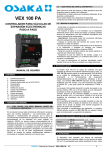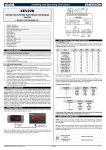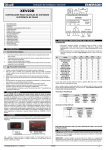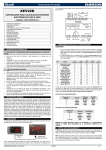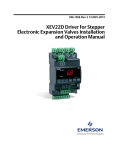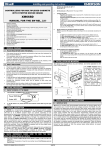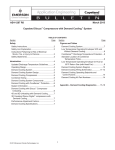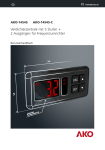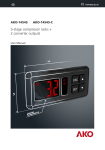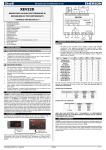Download Emerson XEV22D Technical data
Transcript
cables, from the outputs and the power connections. Do not exceed the maximum current allowed on each relay, in case of heavier loads use a suitable external relay. XEV22D 4.1 DRIVER FOR STEPPER ELECTRONIC EXPANSION VALVES Separate the probe cables from the power supply cables, from the outputs and the power connections. 4.2 --- MANUAL FOR RELEASE 1.5 --1. 2. 3. 4. 5. 6. 7. 8. 9. 10. 11. 12. GENERAL WARNINGS Before connecting cables make sure the power supply complies with the instrument’s requirements. WIRING CONNECTIONS GENERAL WARNING................................................................................................ GENERAL DESCRIPTION ................................................................................................ PROBES RELATED TO THE XEV22D ................................................................ CONNECTIONS ................................................................................................ FRONT PANEL ................................................................................................ USER INTERFACE ................................................................................................ PARAMETER LIST ................................................................................................ FORCED OPENING ................................................................................................ HOW TO: USE THE HOT-KEY ................................................................ DISPLAY MESSAGES ................................................................................................ TECHNICAL DATA ................................................................................................ STANDARD VALUES ................................................................................................ 1. GENERAL WARNING 1.1 PLEASE READ BEFORE USING THIS MANUAL This manual is part of the product and should be kept near the instrument for easy and quick reference. The instrument shall not be used for purposes different from those described hereunder. It cannot be used as a safety device. Check the application limits before proceeding. Dixell Srl reserves the right to change the composition of its products, even without notice, ensuring the same and unchanged functionality 1.2 SAFETY PRECAUTIONS Check the supply voltage is correct before connecting the instrument. Do not expose to water or moisture: use the controller only within the operating limits avoiding sudden temperature changes with high atmospheric humidity to prevent formation of condensation Warning: disconnect all electrical connections before any kind of maintenance. Fit the probe where it is not accessible by the End User. The instrument must not be opened. In case of failure or faulty operation send the instrument back to the distributor or to “Dixell S.r.l.” (see address) with a detailed description of the fault. Consider the maximum current which can be applied to each relay (see Technical Data). Ensure that the wires for probes, loads and the power supply are separated and far enough from each other, without crossing or intertwining. In case of applications in industrial environments, the use of mains filters (our mod. FT1) in parallel with inductive loads could be useful. 2. GENERAL DESCRIPTION The XEV22D module is able to drive a large variety of stepper electronic expansion valves. XEV22D permits to regulate the superheat (SH) of the fluid that runs into refrigerating unit in order to obtain optimized performance and a functioning of the evaporator independent by climatic or load conditions. XEV22D modules are equipped with two probe inputs, one for 4 to 20mA or 0 to 5V pressure transducer and another one for NTC-EU, NTC-US or Pt1000 temperature probe. A LAN connection permits to transmit the pressure signal to others XEV modules in order to use only one pressure transducer in multiplexed cabinet applications. There are also two configurable digital inputs, the first one is free of voltage and the other ones is at high voltage in order to simplify connections with cooling request signal. With the useful display it’s possible to see the value of superheat (SH), the degree of opening of the valve or the probe values, the local keyboard allows programming the instrument without any other devices. To complete instrument equipment, a RS485 serial link permits to connect XEV22D to Dixell monitoring and supervising systems. 4.3 WIRING GUIDELINE 3. PROBES RELATED TO THE XEV22D DEVICE TYPE Analog temp sensor and Digital input Rs-485 network Pressure transducer Stepper valve 3.1 Power loads and valve PP07, PP11, PP30: 4÷20MA PRESSURE TRANSDUCERS NAME PP07 PP11 PP30 3.2 CABLE LENGTH 2,0MT 2,0MT 2,0MT RANGE -0,5+7bar rel FE -0,5+7bar rel FE 0+307bar rel FE DIXELL CODE BE009302 00 BE009302 07 BE009302 04 4.4 AWG 22-2 SHIELDED, E.I. BELDEN #8761 AWG 22-2 SHIELDED, E.I. BELDEN #8761 Use valve manufacturer’s harness with a maximum length, not exceed 10 meters (30 feet). Allow a maximum wire size of 14 AWG (2 mm2) TEMPERATURE PROBE MOUNTING Advised temperature probe placement is illustrated in figure nearby. Between 0 and 180 inclination degrees respect to horizontal pipe section. NP4-67 OR PMP4-67 PIPE MOUNTING TEMPERATURE PROBE The NP4-67 (NTC sensor) or PMP4-67 (PT1000 sensor) temperature probe can be used on the suction line to monitor the evaporator/Heat exchanger outlet temperature. 4.5 NP4-67 - Code BN609001 52 - 1.5MT NTC probe Measurement range: -40+110°C, Cable 1,5mt PMP4-67 - Code BZ609001 53 - 1.5MT Pt1000 probe Measurement range: -70+110°C, Cable 1,5mt PROBE CONNECTION 4.5.1 General warnings Pressure probe (4 - 20mA or ratiometric): respect the polarity. If using terminal ends be sure there are no bear parts which could cause short circuiting or introduce noise disturbance at high frequencies. To minimize the induced disturbances use shielded cables with the shield connected to earth. Temperature probe: it is recommended to mount the temperature probe on the outlet of the evaporator heat/exchanger and to isolate it properly to detect the gas outlet temperature. 4. CONNECTIONS The instrument is provided with pluggable screw terminal block to connect cables with a cross section up to 2.5 mm2. Heat-resistant cables have to be used. Before connecting cables make sure the power supply complies with the instrument’s requirements. Separate the probe cables from the power supply 1592025990 XEV22D GB r1.5 14.11.2014.docx SUGGESTED CABLE AWG 22-2 SHIELDED, E.I. BELDEN #8761 XEV22D 1/6 PP07 PP11, PP30, 4÷20mA pressure transducers: Sporlan 5 SER 1.5-20 6 Set parameter tPP = 420. 7 Connect: Brown wire (+) to terminal 19; White wire (-) to terminal 20 8 9 10 PPR15 PPR30 Ratiometric transducers (0.5÷4.5Vdc) Set parameter tPP = 5U 11 Connect: Brown wire (+) to terminal 18; White wire (in) to terminal 20; Green wire (gnd) to terminal 21 12 13 14 Connect to terminals 13-14 CONFIGURABLE DIGITAL INPUT CONNECTION The superheat regulation is performed only when the cooling digital input is enabled. It’s possible to enable the SH regulation via: Digital input 1, free voltage contact: Use the terminals (14-15), set the parameter i1F = CCL, its polarity it’s set by par. i1P. - 0 159 12 5 200 bP FUL 0 319 16 5 200 bP FUL 0 250 12 5 200 bP FUL 0 638 16 5 200 bP FUL 0 638 16 5 200 bP FUL 0 638 16 5 200 bP FUL 5 75 50 10 500 bP FUL 10 160 75 25 500 bP FUL 10 260 80 50 500 bP FUL uP HAF 4 33 0 0 50 Liability Limitation All the pre-sets have been done according to the documentation available when the XEV22D has been released, see below reference: Danfoss: DKRCC.PD.VD1.C6.02 / 520H8021 @ Danfoss A/S (AC-MCI / sw), 2014-07 Sporlan: 92008 / Bulletin 100-20 RACE Catalogue 100-20-3 EDEV-2/UK - 02/2013 Emerson FC-TD/ EX4-8 July 2008 In any case for each valve the only reference is given by the manual released by the manufacture together with the valve. Dixell can’t be considered responsible for any change made by the manufacturer and reported on the manufacturer manual. Temperature probe: Set parameter ttE = NTC: (NTC 10K) or ttE = Pt1: (Pt1000) or ttE = CtC: (NTC-US 10K) 4.6 Sporlan SEI 30 Sporlan SER(I) G,J,K Sporlan SEI 50 Sporlan SEH(I) 100 Sporlan SEH(I) 175 Emerson EX4-EX5EX6 Emerson EX7 Emerson EX8 500 Emerson EX3 4.8.2 Manual setting of valve To set the valve manually, act the according to the following procedure: a. Set tEP=0 b. Then set following parameters: LSt, USt, Sr, CPP, CHd according to the valve manual Digital input 2 (8-9), main voltage contact Use the terminals (8-9), set the parameter i2F = CCL, its polarity it’s set by par. i1P 4.9 Usually the digital input is connected to a thermostat or an activation contact VALVE CONNECTION 4.9.1 TERMINALS FOR VALVE CONNECTION T= Thermostat ( or activation contact) V= Stepper valve (mono or bipolar) P1= Temperature sensor (PT1000 o NTC or NTC-US) P2= Pressure transducer 4..20mA or ratiometric (0-5Vdc). 4 WIRES VALVES (BIPOLAR) 4.7 Connection numbering 4 2 3 1 SUPPLY CONNECTION Power supply: XEV22D is powered at 24Vac/dc. Use Class 2 transformer at list 20VA as the TF20D Connect transformer to terminals 11-12. 1. 2. 3. Connection numbering 4 2 3 1 5 – Common VALVE CONFIGURATION 4.8.1 BEFORE CONNETTING THE VALVE ALWAYS CONNECT OR DISCONNET THE VALVE WHEN THE CONTROLLER IS NOT POWERED CONFIGURE THE VALVE ON THE XEV22D BEFORE CONNECTING THE VALVE Danfoss 1 ETS-25/50 2 3 4 Danfoss ETS-100 Danfoss ETS250/400 Sporlan SEI 0.5-11 4.10 7 262 10 10 300 bP FUL 10 353 10 10 300 bP FUL 11 381 10 10 300 bP FUL 0 159 16 5 200 bP FUL EMERSON EX3 BLUE BLACK BROWN WHITE GRAY SPORLAN SAGINOMIYA ORANGE RED YELLOW BLACK GRAY ORANGE RED YELLOW BLACK GRAY ABSOLUTE MAXIMUM POWER XEV22D is able to drive a wide range of stepper valves, in the following table are indicated the maximum values of current that the actuator can supply to the stepper wiring. The Dixell transformer to use is the TF20D. NOTE: the electrical power absorption of the valve can be unrelated to refrigeration power that valve has. Before using the actuator, please read the technical manual of the valve supplied by the manufacturer and check the maximum current used to drive the valve in order to verify that they are lower than those indicated below. LSt uSt CPP CHd Sr tEu HSF (steps*10) (steps*10) (mA*10) (mA*10) (step/s) (bip/unip) (Half/full) 1592025990 XEV22D GB r1.5 14.11.2014.docx DANFOSS ETS BLACK WHITE RED GREEN AFTER MAKING THE CONNECTION, PLEASE SWITCH OFF AND ON THE XEV CONTROLLER IN ORDER TO BE SURE OF THE RIGHT POSITIONING OF THE VALVE. BEFORE CONNECTING the valve, to avoid possible problems, configure the driver by making the right changes on the parameters. The max distance between an XM controller and a valve must not exceed 10 m. To avoid any problems, use only shielded cables with section greater than or equal to 0.325 mm² (AWG22). Select the kind of motor (tEU parameter) and check if the valve is present in tEP parameter table reported here below. tEP BLUE BROWN BLACK WHITE SPORLAN SEI-SEH WHITE BLACK RED GREEN 5-6 WIRES VALVES (UNIPOLAR) VALVE TYPE 4.8 ALCO EX XEV22D BIPOLAR VALVES (4 wires) Maximum Current 0.9A UNIPOLAR VALVES (5-6 wires) Maximum Current 0.33A 2/6 4.11 NOTE: IF THE REGULATION IS NOT ENABLED THE CONTROLLER DISPLAYS “PMP”. RS485 SERIAL LINE 6.2 All models can be connected to the monitoring and supervising system XWEB3000. If Mod=Std standard ModBUS-RTU protocol is used, if Mod=AdU custom XWEB library is required. This last configuration makes possible to use the same serial address of the thermostat that gives the cooling request to XEV. In this way, it’s possible to reduce the number of addresses used. 6.3 4.12 HOW TO: SEE THE SET POINT 1) 2) CONNECTION OF XEC SUPERCAP (BACK UP BATTERY) Press the SET buttons until the set point will be showed. To come back to see temperature, wait about 5s or press newly SET key. HOW TO: MODIFY THE SET POINT To change the set point value operate as follows: 1) Press the SET button until the set point will be showed. 2) Use UP or DOWN buttons to change its value. 3) Press SET button to store the new value. XEC Supercap is designed to be used with Dixell products (XM678D, XEV, IEV and others); to close the stepper valve in case of power failure. !!!!! IMPORTANT !!!!! XEC Supercap and XEV22D must be powered by two different transformers; the failure of the observance of this rule may result in damage to the XEC Supercap and / or the connected XEV22D. 6.4 HOW TO: ENTERING “PR1” PARAMETER MENU To enter in “Pr1” level menu: 1) Pressing SET+ DOWN buttons for about 3 seconds. 2) Instruments shows first parameter in Pr1 menu Wiring connection XEV22D Terminal 31 (+) Terminal 30 (gnd) XEC Terminal 4 (12Vdc) Terminal 3 (gnd) 6.5 5. FRONT PANEL HOW TO: ENTERING “PR2” PARAMETER MENU To enter to “Pr2” parameters list: 1. Enter to “Pr1”. 2. Select “Pr2” parameter and press SET. 3. The “PAS” label will be shown, then “0--” with 0 blinking. 4. Insert “321” password through UP and DOWN buttons, then press SET to confirm. 6.6 HOW TO: CHANGE A PARAMETERS VALUE To change the parameter’s value operate as follows: 1. Enter the Programming mode by pressing the SET and DOWN button for about 3s. 2. Select the required parameter. 3. 4. 5. % PRB Press the SET button to display the value. Use UP or DOWN to change the value. Press SET to store the new value and move to the following parameter. To exit: Press SET + UP or wait 30s without pressing any button. NOTE: the set value is stored even when the procedure is exited by waiting the time-out to expire. To display and to modify the set point. In programming mode it selects a parameter or it confirms a value. Push to display pressione per visualizzare il valore apertura valvola 0..100% per qualche secondo. Una pressione per visualizzare il valore di pressione per qualche secondo. By pressing and releasing this key, it’s possible to see the values of the probes. In programming mode it slides the codes of the parameters or it increases their values. In programming mode it slides the codes of parameters or it decreases their values. 7. PARAMETER LIST NOTE: REGULATION FtY KEYS COMBINATIONS 5.1 + To lock or to unlock the keyboard + To enter programming mode. XEV22D LEDS On display there are some luminous dots. Their meaning is described in the following table: LED MODE Function REFRIGERANT r22 r134A r404A r407A r410 r507 r407C r407F OPERATING RANGE -50-60°C/-58÷120°F -70-60°C/-94÷120°F -50-60°C/-58÷120°F -50-60°C/-58÷120°F -50-60°C/-58÷120°F -70-60°C/-94÷120°F -50-60°C/-58÷120°F -50-60°C/-58÷120°F r290 – Propane -50-60°C/-58÷120°F ON Maximum Operating Pressure alarm 290 OFF Valve is completely closed CO2 r744 - Co2 -50-60°C/-58÷120°F 450 r450A -45-60°C/-69÷120°F 513 r513 -45-60°C/-69÷120°F 448 r448A -45-60°C/-69÷120°F 449 r449A -45-60°C/-69÷120°F Reaction time (1÷100s; 0 = automatic time adjustment) time delay between valve position adjustments. It’s the time between the valve adjustment command and when the valve is moved. EI With rEt = 1 the valve is moved continuously, with rEt = 10 the valve is moved every 10s, with rEt = 0 the reaction time is calculated automatically by the system, according the SH variation. The range is between 6÷60s, Probe Error opening percentage: (0 to 100%) if a temporary probe error occurs, valve opening percentage is PEo until PEd time is elapsed. If PEO is different from 0 it assures cooling also with probe error, because even if the device cannot calculate superheat the valve can work at PEo percentage. Probe Error delay before stopping regulation: (0 to 239sec; 240=On=unlimited) if probe error duration is higher than PEd, valve will close completely and “Pf” message will be showed. With PEd=on, valve opening is PEo until probe error finishes. Type of Stepper motor: (UP; bP) it permits to select the kind of valve. UP = Unipolar valves; bP = Bipolar valves. !!!!! WARNING !!!!! This parameter has to be adjusted before connecting the valve. Valve is moving Valve is completely opened BLINKING Serial communication present OFF Serial communication absent ON Superheat alarm rEt 6. USER INTERFACE 4) 5) 6) LABEL R22 134 404 47A 410 507 47C 47F Low pressure alarm ON 2) 3) Kind of gas: type of gas used by plant. This is a fundamental parameter for correct functioning of all system. The table below contains the refrigerant gases managed by the XEV22D and their operating temperature ON BLINKING 6.1 All pressure parameters are relatives or absolutes depending on the PrM parameter. FAST ACCESS MENU (DURING REGULATION) Press and release UP button. The variable available in the Fast access menu are: a. CLP Cooling demand percentage b. tP1 Temperature from Probe 1 c. PPr Pressure value from Probe 2 transducer. d. tP2 Suction temperature obtained from pressure temperature table . e. SH Value of superheat.; f. StH Superheat set point g. oPP Percentage of valve opening. h. d1S Free voltage digital input status i. d2S Main Voltage digital input status VAC Brows parameter labels with UP or DOWN buttons. Press SET to see read-only value. To change parameter, press SET. To leave the fast access menu, press and release SET+UP or wait for time-out to expire (about 3 minutes). 1592025990 XEV22D GB r1.5 14.11.2014.docx PEo PEd tEU XEV22D 3/6 tEP Predefined valve selection: (0 to 14) MODEL Danfoss 1 ETS-25/50 2 3 4 5 6 7 8 9 10 11 12 13 14 Danfoss ETS-100 Danfoss ETS250/400 Sporlan SEI 0.5-11 Sporlan SER 1.5-20 Sporlan SEI 30 Sporlan SER(I) G,J,K Sporlan SEI 50 Sporlan SEH(I) 100 Sporlan SEH(I) 175 Emerson EX4-EX5EX6 Emerson EX7 Emerson EX8 500 Emerson EX3 MnF LSt uSt CPP CHd Sr tEu HSF (steps*10) (steps*10) (mA*10) (mA*10) (step/s) (bip/unip) (Half/full) 7 262 10 10 300 bP FUL 10 353 10 10 300 bP FUL 11 381 10 10 300 bP FUL 0 159 16 5 200 bP FUL 0 159 12 5 200 bP FUL 0 319 16 5 200 bP FUL 0 250 12 5 200 bP FUL 0 638 16 5 200 bP FUL 0 638 16 5 200 bP FUL 0 638 16 5 200 bP FUL 5 75 50 10 500 bP FUL 10 160 75 25 500 bP FUL 10 260 80 50 500 bP FUL uP HAF FoP PI PARAMETERS (trained staff) AMS Atu 4 33 0 0 50 LSt USt ESt Sr CPP CHd oPE SFd dty Proportional band: (0.1 to 50.0°C; 1 to 90°F) PI proportional band. A value bigger than 5°C is advised. rS Band Offset: (-12.0 to 12.0°C; -21 to 21°F) PI band offset. It permits to move the proportional band of the PI. With rS=0 the band is between [SEt to SEt+Pb]. inC dFc Integration time: (0 to 255s) PI integration time. Derivative time (0 to 255s) PID derivative time. PROBE PARAMETERS tPP LPP PA4 P20 oPr ttE otE Manual valve setting To set the valve manually, act the according to the following procedure: a. Set tEP=0 b. Then set following parameters: LSt, USt, Sr, CPP, CHd according to the valve manual Kind of motor movement: (HAF; FUL) HAF = half step. Use this setting for the unipolar valve. FUL = full step. Use this setting for the bipolar valve. Minimum number of steps: (0 to USt (*10)) it permits to select the minimum number of steps. At this number of steps the valve should be closed. So it’s necessary the reading of manufacturer datasheet to set correctly this parameter. It’s the minimum number of steps to stay in advised range of functioning. !!!!! WARNING !!!!! after changing this parameter the valve will have to be reinitialized. The device performs this procedure automatically and restarts its normal functioning when the programming mode ends. Maximum number of steps: (LSt to 800 (*10)) it permits to select the maximum number of steps. At this number of steps the valve should be completely opened. Read the datasheet provided by manufacturer of the valve to set correctly this parameter. It’s the maximum number of steps to stay in advised range of functioning. !!!!! WARNING !!!!! after changing this parameter the valve will have to be reinitialized. The device performs this procedure automatically and restarts its normal functioning when the programming mode ends. Extra step in closing phase: (0 to 255 (*10)) it sets the number of extra steps the controller performs, when the valve is closed at start up, to force the closure of the valve. Step rate: (10 to 600 step/sec) it is the maximum speed to change step without losing precision (=losing steps). It’s advised to stay under the maximum speed. Current per phase (only bipolar valves): (0 to 100 (*10mA)) it is the maximum current per phase used to drive valve. It’s used only with bipolar valves. Holding current per phase (only bipolar valves): (0 to 100 (*10mA)) it is the current per phase when the valve is stopped for more than 4 minutes. It’s used only with bipolar valves. Start opening Percentage: (0 to 100%) opening valve percentage when start function is active and during post defrost phase. This phase duration is SFd time. Start Function duration: (0.0 to 42min 00s, res. 10s) it sets start function duration and post-defrost duration. During this phase the alarms are not enabled. Pilot duty: (2-10dec/sec) To reach the final position the valve moves for Ton sec and stops for Tof sec, where Ton and Tof are defined as in the following:. Ton= dty/10s Toff= (1-dty/10)s Note: with dty=10 the Pilot duty function is disabled. With bipolar valve, during the Toff time the maintenance current is used. 1592025990 XEV22D GB r1.5 14.11.2014.docx Self self adaptive SH regulation enabling: parameter enables the self adaptive regulation of the superheat no = standard regulation using the PID parameters (Pb, rS, inC, dFC) yES = self-adaptive regulation, controller regulates SH automatically, setting the PID parameter Minimum STABLE superheat search (No; yES) This parameter enables the search of the minimum stable superheat. The lowest admitted value is LSH+2°C Pb Liability Limitation All the pre-sets have been done according to the documentation available when the XEV22D has been released, see below reference: Danfoss: DKRCC.PD.VD1.C6.02 / 520H8021 @ Danfoss A/S (AC-MCI / sw), 201407 Sporlan: 92008 / Bulletin 100-20 RACE Catalogue 100-20-3 EDEV-2/UK - 02/2013 Emerson FC-TD/ EX4-8 July 2008 In any case for each valve the only reference is given by the manual released by the manufacture together with the valve. Dixell can’t be considered responsible for any change made by the manufacturer and reported on the manufacturer manual. HFS Maximum opening percentage at normal Functioning: (0 to 100%) during regulation it sets the maximum valve opening percentage. Forced Opening percentage: (0 to 100; nU) if FoP=nU valve works with regulation algorithm. If FoP is different from nU the valve stays at FoP opening percentage. This function could be useful during plant starting or during service operations. Type of Pressure transducer: (420; 5V; LAn) it sets type of pressure transducer to use. 420 = 4 to 20mA pressure transducer; 5V = 0 to 5V ratiometric transducer; LAn = the pressure signal comes from another XEV module. Enable pressure probe sending in LAN: (n; Y) if LPP=Y the value of pressure read by device is sent in LAN. Only one device of the LAN can have LPP=Y. Probe value at 4mA or at 0V: (-1.0 to P20 bar; -14 to P20 psi) pressure value measured by probe at 4mA or at 0V (related to PrM parameter). Probe value at 20mA or at 5V: (PA4 to 50.0 bar; PA4 to 725 psi) pressure value measured by probe at 20mA or at 5V (related to PrM parameter). Pressure probe calibration: -12.0 to 12.0 bar; -174 to 174 psi. Type of temperature probe: (PtM; ntC) it allows to set the kind of probe used by the instrument: PtM = PT1000 probe, ntC = NTC-US probe. Temperature probe calibration: -12.0 to 12.0°C; -21 to 21°F. DIGITAL INPUTS i1P i1F d1d i2P i2F d2d Digital Input 1 (Free of voltage) digital input polarity: (cL, oP) CL = activated when closed; oP = activated when opened. Digital Input 1 (Free of voltage) digital input function: (CCL, rL) CCL = cooling call; rL = digital input activates relay. Digital Input 1 (Free of voltage) activation delay: (0 to 255 min) this activation delay is used only if digital input is configured as rL. Digital Input 2 (High voltage) digital input polarity: (CL, oP) CL = activated when closed; oP = activated when opened. Digital Input 2 (High voltage) digital input function: (CCL, rL) CCL = cooling call; rL = digital input activates relay. Digital Input 2 (High voltage) activation delay: (0 to 255 min) this activation delay is used only if digital input is configured as rL. ALARM dAo tdA LPL MoP LoP PHY dML MSH XEV22D Alarm delay after restarting regulation: (0.0 to 42min 00s, res. 10s) time between digital input activation (configured as CCL) and alarm signalling. The LSH alarm is always signalled also during this time. Type of alarm signalled by relay: (ALL, SH, PrE, di) ALL = all alarm; SH = superheat alarm; PrE = pressure alarm; di = activation only when digital input configured as rL is active. Lower Pressure Limit for superheat regulation: (PA4 to P20 bar; PA4 to P20 psi) when suction pressure comes down to LPL, the regulation is performed with a LPL fixed value for pressure. When suction pressure comes back to LPL, the normal pressure value is used (related to PrM parameter). Maximum Operating Pressure threshold: (LoP to P20bar; LoP to P20 psi) if suction pressure exceeds maximum operating pressure value, the instrument signals this situation with an alarm LED (related to PrM parameter). Lowest Operating Pressure: (PA4 to MoP bar; PA4 to MoP psi) if the suction pressure comes down to this value, a low pressure alarm will be signalled with an alarm LED (related to PrM parameter). Pressure alarm Hysteresis: (0.1 to 5.0 bar, 1 to 72 psi) pressure hysteresis to disable alarm signalling. Delta MoP-LoP: (0 to 100%) when a MoP alarm occurs valve will close of the dML percentage every one second until MoP alarm is active. When LoP occurs, valve will open of the dML percentage every one second until LoP alarm is active. Maximum SuperHeat alarm: (LSH to 80.0°C; LSH to 144°F) when superheat exceeds this value, an high superheat alarm will be signalled after interval SHd. 4/6 LSH Lowest SuperHeat alarm: (0.0 to MSH°C; 0 to MSH°F) when superheat goes down to this value a low superheat alarm is signalled after interval SHd. SuperHeat alarm Hysteresis: (0.0 to 25.5°C; 1 to 77°F) hysteresis for superheat alarm deactivation. SuperHeat alarm activation delay: (0 to 255 s) when a superheat alarm occurs, the delay time SHd have to expire before signalling this alarm. Pressure stability index (0-240s). The value used for the SH calculation is the average value of the pressure in the tdS time. Suggested values: tdS: 5-10 for heat exchanger or condensing unit tdS: 1-6 for supermarkets Temperature stability index (0-240s). The value used for the SH calculation is the average value of the temperature in the tdt time. A value between 1-3 his suggested SHY SHd tdS tdt Mess. “EE” Memory error 10.1 CF PMU rES PrM CLP tP1 PPr tP2 SH STH oPP d1S d2S ALARM RECOVERY 11. TECHNICAL DATA Housing: self extinguishing ABS. Case: 4 DIN modules 70x135mm with male and female connectors; depth 60mm. Mounting: DIN RAIL mounted in an omega (3) din rail. Protection: IP20. Connections: pluggable screw terminal block 2.5 mm2 wiring. Power supply: 24Vac/dc ±10%. Power absorption: depending on connected valve 20VA max. Display: three digits with icons, red LEDs, height 14.2 mm. Inputs: 1 temperature probe: PT1000 probe: -50 to 110°C (-58 to 230°F). NTC probe: -40 to 110°C (-40 to 230°F). 1 pressure transducer: 4 to 20mA or 0 to 5V. Digital inputs: 1 free of voltage. 1 high voltage. Outputs for valve: bipolar or unipolar valves. Data storage: on the non-volatile memory (EEPROM). Kind of action: 1B. Pollution degree: normal. Software Class: A. Operating temperature: 0 to 55°C (32 to 131°F). Storage temperature: -25 to 60°C (-13 to 140°F). Relative humidity: 20 to 85% (no condensing). Resolution: 0.1°C or 1°F. Precision a 25°C (77°F): ±0.7°C ±1digit. Local display: (SH; PEr; P1; P2) SH = superheat; PEr = valve opening percentage; P1 = value of temperature measured; P2 = pressure measured by P2 probe. Temperature measurement units: (°C; °F) °C = Celsius degree; °F = Fahrenheit degree. NOTE: by changing measurement unit, the regulation parameters have to be correctly changed. Pressure Measurement units: (bAr, PSi) bAr = bar; PSi = psi. NOTE: by changing measurement unit, the regulation parameters have to be correctly changed. Resolution (only °C): (dE; in) dE = decimal format; in = integer format. Pressure visualization Mode: (rEL; AbS) rEL = relative pressure; AbS = absolute pressure. All pressure parameters depend on this parameter. Cooling Percentage (read only): Display the cooling percentage. Temperature Probe value (read only): it shows temperature probe value from P1. Pressure probe value (read only): it shows pressure probe value. The value depends on PrM. Temperature from P2 (read only): it shows temperature obtained from conversion of pressure value. Super heat value Superheat set point value Opening Percentage (read only): it shows the actual opening percentage of the valve. Free of voltage digital input State (read only): it shows the free of voltage digital input. High voltage digital input State (read only): it shows the high voltage digital input state. RS485 Serial Address: (1 to 247) Identifies the instrument address when connected to a ModBUS compatible monitoring system. ModBus: (AdU; Std) AdU = (Only for XWEB systems) in this case XEV and thermostatic controller are considered an alone instrument (it requires a custom library for XWEB); Std = to use XEV in stand-alone mode, in this case normal Modbus-RTU protocol is used. Parameters map: (read only) it identifies parameters map written by factory. Release Firmware: (read only) it shows firmware release. Second level menu. 12. STANDARD VALUES Label Description FtY Kind of gas PEo 9. HOW TO: USE THE HOT-KEY oPE Probe Error opening percentage Probe Error delay before stopping regulation Type of Stepper motor Automatic Valve configuration Kind of driving Minimum number of steps Maximum number of steps Extra steps in closing phase Step rate Current per phase (only bipolar valves) Holding current per phase (only bipolar valves) Start opening Percentage 9.1 SFd Start Function duration Sti Stop regulation interval Adr Mod Ptb rEL Pr2 PEd tEU tEP HFS LSt USt ESt Sr CPP 8. FORCED OPENING If necessary, by changing FoP parameter it’s possible to force the valve opening. For example, by setting FoP=50 the valve will be open at half of full scale. To disable this function it’s necessary to set FoP=nU (default value). The valve opening is enabled only when CCL digital input is enabled. CHd PROGRAM A HOT-KEY FROM THE INSTRUMENT (UPLOAD) 1) 2) Program one controller with the front keypad. When the controller is ON, insert the HOT-KEY and push UP button; the “uPL” message appears followed a by flashing “End”. Push SET button and the “End” will stop flashing. Turn OFF the instrument, remove the HOT-KEY and then turn it ON again. 3) 4) Std Stop duration MnF Maximum opening percentage FoP Forced Opening time-out PI PARAMETERS (trained staff) Self self adaptive SH regulation AMS enabling SSH Superheat set point NOTE: the “Err” message is displayed in case of any failed programming operation. In this case, push again UP button if you want to restart the upload again or remove the HOT-KEY to abort the operation. 9.2 PROGRAM AN INSTRUMENT USING A HOT KEY (DOWNLOAD) 1) 2) 3) 4) 5) Turn OFF the instrument. Insert a pre-programmed HOT-KEY into the 5-PIN connector and then turn the Controller ON. Automatically the parameter list present into the HOT-KEY will be downloaded into the Controller memory. The “doL” message will blink during this operation, followed a by a flashing “End” label. After 10 seconds the instrument will restart working with the new parameters. Remove the HOT-KEY. 10. DISPLAY MESSAGES “PF” “P1” “P2” “HSH” “LSH” “LPL” “MoP” “LoP” “StF” “StP” The Ped time is elapsed and the regulation is stopped Temperature probe fault Pressure transducer fault High superheat alarm Low superheat alarm Low pressure limit Maximum Operating Pressure Lowest Operating Pressure Start Function enabled Regulation stop caused by Std and Sti 1592025990 XEV22D GB r1.5 14.11.2014.docx Pb Proportional band rS Band Offset inC Integration time dFC Derivative time PROBE PARAMETERS tPP Type of pressure transducer LPP Enable pressure probe sending in LAN Probe value at 4mA or at 0V (related to PA4 PrM parameter) Probe value at 20mA or at 5V (related P20 to PrM parameter) NOTE: the “Err” message is displayed in case of any failed programming operation. In this case, push again UP button if you want to restart the upload again or remove the HOT-KEY to abort the operation. Mess. Cause “PMP” None of digital inputs configured as CCL are activated Outputs - Probe alarms “P1”, “P2” start few seconds after the fault in the probe; they automatically stop few seconds after the probe restarts normal operation. Check connections before replacing the probe. Max. And min. Alarms “HSH”, “LSH”, “MoP” and “LoP” automatically stop as soon as the variable returns to normal values. The instrument is provided with an internal check verifying memory integrity. Alarm “EE” will flash when a failure in the internal memory is detected. In such case call the service. DISPLAY Lod Cause Outputs Valve closed Valve closed after PEd. There is a probe error According to PEo and PEd. According to PEo and PEd. By PI Valve Closed see LPL parameter see dML parameter see dML parameter see SFd parameter Valve closed oPr Pressure probe calibration ttE type of temperature probe otE Temperature probe calibration DIGITAL INPUTS i1P Free of voltage digital input polarity i1F Free of voltage digital input function Digital input 1 (free of voltage) d1d activation delay i2P Main voltage digital input polarity i2F Main voltage digital input function d2d Digital input 2 (Main voltage) activation XEV22D Range R22; 134; 404; 407; 410; 507; Co2 0 to 100 % Default Level 404 Pr2 1 Pr2 0 to 239 s; on 50 Pr2 uP; bP 0 to 10 HAF; FUL 0; USt (*10) LSt to 800 (*10) 0 to 255 (*10) 10 to 600 step/s 0 to 100 (*10mA) On bP 0 FUL 0 0 0 10 Pr2 Pr2 Pr2 Pr2 Pr2 Pr2 Pr2 Pr2 0 to 100 (*10mA) 0 Pr2 0 to 100 % 0.0 to 42min 00s, res. 10s 0.0 to 24h 00min, res. 10min 0 to 60 min 0 to 100 % 0 to 100 %; nU 0 Pr2 80 Pr2 30 Pr2 10 100 nu Pr2 Pr2 Pr2 No; yES n Pr2 No; yES [0.1 to 50.0°C] [1 to 90°F] [-12.0 to 12.0°C] [-21 to 21°F] 0 to 255 s 0 to 255 s 420; 5V; LAn n; Y [-1.0 to P20 bar] [-14 to P20 psi] [ PA4 to 50.0 bar] [PA4 to 725 psi] [-12.0 to 12.0 bar] [-174 to 174 psi] PT1000; ntC [-12.0 to 12.0°C] [-21 to 21°F] n Pr2 12 Pr2 0.0 Pr2 180 2 Pr2 Pr2 420 n Pr2 Pr2 -0.5 Pr2 11 Pr2 0.0 Pr2 PtM Pr2 0,0 Pr2 cL CCL Pr2 Pr2 0 to 255 min 0 Pr2 CL; oP CCL, rL 0 to 255 min cL CCL 0 Pr2 Pr2 Pr2 CL; oP CCL; rL 5/6 delay ALARMS dAo Alarm delay after restarting regulation tdA bon tbA Type of alarm signalled by relay Buzzer enabling Alarm relay silencing Lower pressure limit for superheat regulation (related to PrM parameter) Maximum operating pressure threshold (related to PrM parameter) Minimum suction pressure limit (related to PrM parameter) LPL MoP LoP PHy Pressure alarm Hysteresis dML delta MoP-LoP MSH Maximum superheat alarm LSH Lowest superheat alarm SHY Superheat hysteresis SHd DISPLAY tdS tdt Lod CF PMu rES PrM CLP tP1 PPr tP2 SH STH oPP d1S d2S Adr Mod Ptb rEL Pr2 Superheat alarm activation delay Pressure stability index Temperature stability index Local display Temperature measurement units Pressure measurement unit Resolution (only °C) Type of pressure (Absolute / relative) Cooling call percentage Temperature probe value Pressure probe value Temperature converted from pressure probe Super heat value Superheat set point valu Actual Opening percentage Free of voltage digital input state Main voltage digital input state Serial address Modbus type Parameters map Release software Second level menu 1592025990 XEV22D GB r1.5 14.11.2014.docx 0.0 to 42min 00s, res. 10s ALL; SH; PrE; Di No; yES No; yES [PA4 to P20 bar] [PA4 to P20 psi] [LoP to P20 bar] [LoP to P20 psi] [PA4 to MoP bar] [PA4 to MoP psi] [0.1 to 5.0 bar] [1 to 72 psi] 0 to 100% [LSH to 80.0°C] [LSH to 176°F] [0.0 to MSH°C] [0 to MSH°F] [0.1 to 25.5°C] [1 to 77°F] 0 to 255 s 10.0 Pr2 ALL n n Pr2 Pr2 Pr2 -0.5 Pr2 11.0 Pr2 -0.5 Pr2 0.2 Pr2 5 Pr2 80.0 Pr2 2.5 Pr2 0,5 Pr2 30 Pr2 0-240s 0-240s SH; PEr; P1; P2 °C; °F bAr; PSi dE; in rEL; AbS Read only Read only Read only Read only 5 3 SH °C bAr dE rEL ------- Pr2 Pr2 Pr2 Pr2 Pr2 Pr2 Pr2 Pr1 Pr1 Pr1 --- Pr1 Read only Read only Read only Read only Read only 1 to 247 Std; AdU ------- ----------1 Std 1.5 - Pr1 Pr1 Pr1 Pr1 Pr1 Pr2 Pr2 Pr2 Pr2 Pr1 XEV22D 6/6







